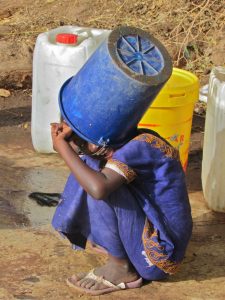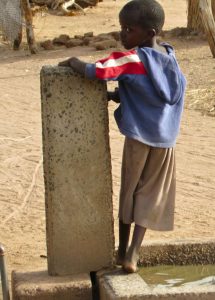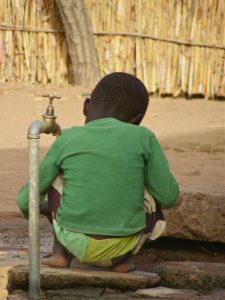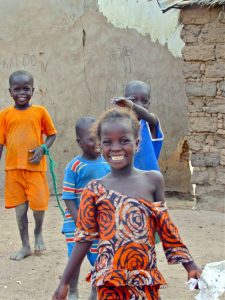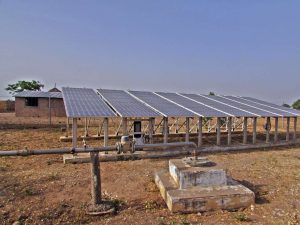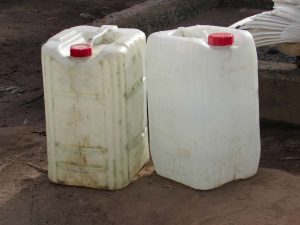This project is made possible through the partnership of WATER CHARITY and the NATIONAL PEACE CORPS ASSOCIATION. ![]()
Location
Boiram, The Gambia
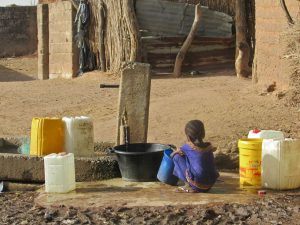 Community Description
Community Description
The country of The Gambia, which surrounds The River Gambia, has a population of 1,882,450 people. Of the five regions, the Janjangbureg region in Central River Region and the Basse Local Government Area in the Upper River Region, have the poorest rating on social indicators in comparison to the other regions. Much of UNICEF’s area-based interventions are focused in these two regions, with a view to closing the equity gap between the more privileged and most vulnerable.
Boiram, which is 20 km from the city of Janjangbureh, is a 4,000-5,000-person village located in the CRR region of The Gambia. It is an agricultural-based community whose primary source of income includes farming (rice, coos, peanut, and corn) and the peanut trade industry. It is involved in many outreaching programs including VDC (village development Committee), VSG (village support group), PTA (Parent-Teacher Association), NANA (National Nutrition Agency) applicant and many more agricultural-based committees.
The school located within the village is a basic cycle school (up to grade nine) and serves the neighboring 5 villages. Currently, there is a CHN (community health nurse) who lives in Boiram and serves the neighboring villages (up to 10 km).
The village consists of 160 compounds. There has been a 68.8 % increase in population in the last year and a half, which has limited the water supply tremendously. This has caused countless village conflicts regarding water usage, school absences, and increased parasitical disease rates resulting from the intake of open well water.
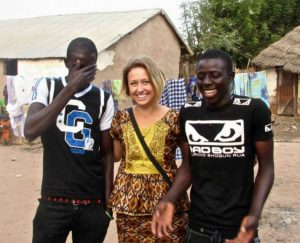 Problem Addressed
Problem Addressed
There is a high mortality rate for children under five, and only 32% of households have an improved drinking water source on their premises.
The use of unprotected wells for drinking water is common in the predominantly rural areas, at 21.8% and is highest in the Janjanbureh Local Government Area (LGA), situated in the Central River Region, with about 30%. In terms of sanitation, 40% do not have access to sanitation.
Boiram is located in the Central River Region and is facing continuous village expansion. In addition to high child diarrhea rates, women bear the burden of the shortage of water. From 2-5 in the afternoon, 80% of the taps open.
Each woman is allotted two 20-liter water units and spends every minute at the tap so as not to miss her turn and lose her opportunity at a day’s clean water supply. This impairs school attendance for young girls who must help carry water, interpersonal relationships, and prospects for financial stability.
Project Description
This project is to build a borehole and install a piping system for Boiram village.
Modern borehole drilling technology and equipment will be used to drill the borehole, and solar power will serve as the main source of energy to pump water.
With the support of the PCV the community will hire a competent and qualified water engineering company to deliver the project. Upon signing the contract, the contractor will start drilling the borehole, to a depth of about 50 meters, within 7 days, supply the solar panels and connect the borehole to the existing 100,000-liter tank, as well as extend the pipe network to provide an additional 6 taps.
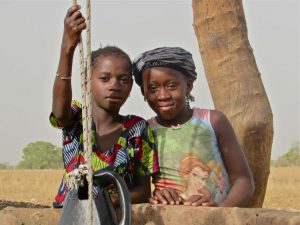 The PCV, counterparts, and staff from the Department of Water Resources in CRR will train 10 water committee members on water hygiene, sanitation, basic water system maintenance and management of the solar panels.
The PCV, counterparts, and staff from the Department of Water Resources in CRR will train 10 water committee members on water hygiene, sanitation, basic water system maintenance and management of the solar panels.
Through the support of the PCV and counterpart, the committee members will turn in train 36 community cluster representatives.
Water Charity funds will be used to pay for the mobilization cost of the machinery to drill the borehole, provide antisol, casing, and screen for the borehole, as well as pay for the digging of a trench for borehole housing, installation of a new submersible pump: (Grundfos Pump SQ flex DC/AC Pump), construction of the solar support structure, and installation of 8 solar panels with all necessary cables and connections.
Currently, 23 stand taps are in the community and this will be increased to 29 through this project.
Project Impact
5,000 people will benefit from the project.
Peace Corps Volunteer Directing Project
Cameron Hatlevig
Monitoring and Maintenance
A two-day intensive water system management and facility maintenance training to strengthen the local community members’ capacities in order to ensure the sustainability of the project.
After construction is completed, a 1-dalasi monthly payment will be collected from each user by the water committee. Under the responsibility of the village secretary, funds will be deposited into a bank account, so that there will be funds available when needed for maintenance, repairs, and expansion.
Let Girls Learn
This project is a Peace Corps Let Girls Learn Project.
Countless young women wait hours for their chance to draw water. Since women predominately secure drinking water and bathing water, they are the ones who are being forced to sacrifice their time and energy. This project, to make water readily available, increases their ability to go to and remain in school.
Comments
This project will provide for an increased water capacity for the entire village, doubling the water supply, and allowing women to fetch water twice a day and for longer periods of time.
The project will improve the overall health of the village and will serve to empower women. Fiscal responsibility, fundraising, budgeting, community-based project management, proper handling and treatment of water, as well as management of a solar water facility will also be improved.
Fundraising Target
$5,000
Funds raised in excess of the project amount will be allocated to other projects in the country.
Donations Collected to Date
$0
ADOPT THIS PROJECT BY CONTRIBUTING THE DOLLAR AMOUNT OF THE PROJECT
Donations of any amount will be appreciated. The full amount will give you “naming rights”, if that is something you would like.
Dollar Amount Needed
$5,000
